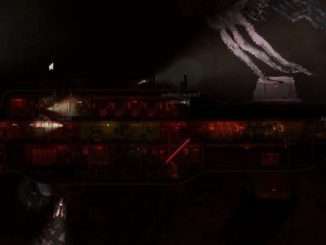
A medical guide meant to help crewmembers understand how to properly use medicine. While not as in-depth as other medical guides, this guide provides important tips and protocols for treating the afflicted, and provides a basic understanding of medicine to otherwise ignorant crewmates.
The Basics
I’m going to start off with basic information before I go further into depth. I highly recommend everyone reads this guide, because if you don’t understand meds well you’re probably gonna ♥♥♥ yourself over eventually. Thanks to the Halloween update, the most common cause of death is now opiate overdose. There are several types of damage and afflictions that someone / something can suffer, I’m going to inform you on all the possible afflictions and their treatments, without going too in-depth. The treatment options will be underlined, in order of most recommended to least. Also, remember that when I say “opiates” I am referring to opium, morphine and fentanyl. Morphine and fentanyl are advanced forms of opium.
Basic Afflictions
- Bleeding – The character is bleeding from a wound at a varying rate. They will slowly suffer blood loss. Plastiseal, bandages, antibiotic glue.
- Gunshot wound – Essentially the same as bleeding, but obviously caused by a bullet. A gunshot wound may be more difficult to bandage, and may bleed more rapidly. Bandages, plastiseal, antibiotic glue.
- Internal damage – Probably the most common damage experienced, caused by blunt trauma. A crowbar, being thrown across the submarine by a crash, and many more causes. Opium, morphine, fentanyl.
- Burn – Caused by fire, welding tools, and more of what you’d expect. For the most part, it’s treated the same way as internal damage. Opium, bandages, morphine, fentanyl.
- Blood loss – As the name implies. This should be treated after treating the cause of the blood loss, unless they are about to die from the blood loss. Blood packs, saline.
- Oxygen loss – The character is low on oxygen. This is extremely important to treat. Stabilozine, CPR, liquid oxygenite.
- Stun – This shouldn’t be a concern. It typically results from someone stunning them with chemicals, a stun baton, etc. It may also mean they have left the server. Hyperzine, methamphetamine.
- Barotrauma – Water pressure. This occurs whenever you leave the submarine with or without a suit, but if you have a suit it will never actually kill you. This can also occur inside the submarine if it is flooding and the water has nowhere to go.
Advanced Afflictions
- Husk infection – A parasite has infected the character. Cure this ASAP, and do NOT kill the character if they are in the advanced stages of the infection, or else they will be resurrected as a husk. Calyxanide, antibiotics.
- Space herpes – Caused by low karma. This can cause inverted controls and distorted view. Cannot be cured with meds, you have to appease the gods by being a good bean.
- Disoriented – Same effects as space herpes but without the appearance of herpes. Can only be caused by admin commands.
- Psychosis – Caused by entering the ruins, ingesting alien blood, or suffering from deliriumine. Causes hallucinations. Not serious. Haloperidol.
- Drunk – Caused by ingesting ethanol. Similar to being disoriented, and the victim may pass out randomly. This can kill you, and there isn’t any treatment for it specifically, but oxygen loss from it can be treated.
- Opiate addiction – Caused by opiate usage (morphine, opium, fentanyl). If not provided with enough opiates the character will eventually go into withdrawal. You should prioritize curing this with naloxone rather than giving more opiates. Naloxone, avoiding opiates.
- Opiate withdrawal – Causes disorientation and weakness. It can eventually lead to death. The latest update has made opiates extremely dangerous. Naloxone, opiates.
- Opiate overdose – Caused by taking opiates. Even one dose of opium can cause a minor overdose. This is why opiates should be used only for major injuries, and should be used conservatively. Can become lethal VERY quickly. Naloxone, AVOID OPIATES.
- Radiation sickness – Caused by radiotoxin or a reactor explosion. Will slowly inflict burns, and the victim may not understand what’s causing the burns. Antirad, opiates can delay.
- Morbusine poisoning – Caused by poisoning. Will inflict a slow death unless treated. Morbusine antidote.
- Sufforin poisoning – Same as morbusine. Sufforin antidote.
- Deliriumine poisoning – Will not kill the victim, but inflicts psychosis, so don’t waste haloperidol on the victim until you cure the deliriumine. Deliriumine antidote, haloperidol can reduce symptoms.
- Cyanide poisoning – Same as morbusine and sufforin, but weaker. Very easy to make. Cyanide antidote.
- Slow metabolism – From tonic liquid. Increases the time all buffs last.
- Hyperactivity – Makes you go fast as ♥♥♥. Caused by meth and hyperzine, Aka “The zooms.”
- Husk infection resistance – Caused by alien blood, does as the name implies.
- Psychosis resistance – What the name implies.
- Pressure resistance – Prevents barotrauma. Only applied by admin commands.
- Vigor – Caused by steroids. Increases vitality, good for combat.
Medical Items
I’m going to show you all the medical items now, and inform you on their effects and uses. I’m not going to go over any items that don’t give effects, or cures for most poisons since they’re pretty obvious as to how they look and work. Also remember that in-game sprites look different from in-inventory sprites. Take a look at the visual guide for help. You may not get as many uses out of a medical item if you skill is low, and the effectiveness will also be poorer.
Opiates
- Opium (1) – Treats internal damage and burns, but rather weak. Recommended for minor afflictions. Two uses.
- Morphine (2) – For more severe internal damage / burns. Do not give anymore than one dose. Two uses.
- Fentanyl (3) – An extremely powerful opiate. You should honestly never use this for healing, since it will cause a major overdose and addiction, even just one dose. Two uses.
Wound Dressing
- Bandages (4) – Effective at treating bleeding, gunshot wounds, and burns. One use.
- Plastiseal (5) – Bandages with multiple uses, but weaker than bandages. Four uses.
- Antibiotic glue (6) – Really weak despite its description. Up to five uses.
Blood-Based
- Saline (7) – Somewhat treats blood loss. Four uses.
- Blood packs (8) – Treats blood loss very effectively. Two uses.
- Alien blood (9) – Not very good at treating blood loss, and gives you blood loss, but it can provide husk resistance. Two uses.
Lethal
- Velonaceps Calyx Eggs (Husk Eggs) (10) – Inflicts the husk parasite. Two uses. Can be used to make up to four calyxanide, the husk cure. Remember that it may take more than one dose of calyxanide to cure the husk infection, and it will not help infected that are in the later stages.
- Broad-Spectrum Antibiotics (11) – Causes internal damage, but can slightly cure husk infection, and increase resistance against it. Useful if there is no calyxanide available. Use opiates to heal damage. Two uses.
- Cyanide (12) – A weak poison that is pretty easy to craft. Slowly kills you. Has its own cure. Two uses.
- Deliriumine (13) – Causes psychosis, not lethal but just annoying. Cure with the antidote then give haloperidol. Two uses.
- Morbusine (14) – A deadly poison that slowly kills. Has its own cure. Two uses.
- Sufforin (15) – Same as morbusine, just uses its own separate antidote. Two uses.
- Radiotoxin (16) – Causes radiation sickness. Cured with antirad. Two uses.
- Nitroglycerin (17) – Not necessarily a poison or medical supply. Causes a massive explosion, so do not ever touch it, go down stairs with it, or run with it.
- Sulphuric acid (18) – Causes severe burns, 4 doses is about enough to KO a healthy person. Two uses.
Dangerous
- Chloral hydrate (19) – Stuns the victim for a short time. Can be used to craft cyanide. Two uses.
- Flash powder (20) – Used in crafting. when thrown it may cause a small explosion, but it’s not very damaging.
- Ethanol (21) – Used in lots of crafting. Can be ingested to get drunk, which may kill. Two uses.
- Liquid oxygenite (22) – Good at treating oxygen loss, but can cause some damage, and is prone to exploding. Two uses.
Other
- Naloxone (not on image) – very important to keep this on you. Naloxone treats opiate addiction, withdrawal, and overdose. This could save you or someone’s life, especially if someone goes crazy and tried to poison people with opiates. Two uses.
- Deusizine (23) – A powerful med that treats oxygen loss, internal damage, and blood loss. Very minor side effects. Two uses.
- Anabolic steroids (24) – Gives the user vigor, which increases their vitality. Can be used to temporarily bring someone KOd back up for a bit to treat themselves or escape danger. May cause psychosis. Two uses.
- Haloperidol (25) – Treats psychosis, that’s all. Two uses.
- Stabilozine (26) – Mostly used for crafting but can effectively treat oxygen loss and can help a little with other injuries, but not very much. Has no side-effects though. Two uses.
- Tonic liquid (27) – Mostly used for crafting, but causes a slow metabolism, making buffs last longer. Four uses.
Meth
- Hyperzine (28) – Powerful methamphetamine that makes you fast as hell and may wake up someone who is stunned. Two uses.
- Methamphetamine (29) – Simple meth. Same as hyperzine but a bit weaker. May cause psychosis. Two uses.
Treatment Plans
This information is very valuable to everyone, even non-medics. However, please remember that if you are not a trained professional, your treatment will be less effective. If you aren’t trained, you should also avoid performing CPR, as it will typically only cause more damage.
The Patient is in Critical Condition and / or Unconscious
Quickly figure out the most urgent health issue to address. Remember that the patient may stop breathing if unconscious for too long, and you should always consider this. Opiates also cause significant oxygen loss and overdose, so avoid resorting to opiates.
- If the patient is rapidly bleeding, treat their wounds quickly. Provide a blood pack quickly if they are on the edge of life. Remember that bandages are the most effective at treating open wounds. Once the bleeding has stopped, provide a blood pack.
- If the patient is about to die from suffocation, identify the cause of oxygen loss. Their suit or diving mask may have no oxygen left, or they may have stopped breathing due to being unconscious so long. Provide them with a suit or diving mask always, even if they aren’t underwater, and perform CPR if you are trained to do so. Stabilozine, deusizine, and liquid oxygenite are all effective at treating oxygen loss, and should be used quickly if they are near-death.
- If the patient has suffered internal damage or burns, slowly administer weak opiates. Too much will cause them to suffocate, as they are much more prone to oxygen loss while unconscious. Ensure that they are breathing properly and are not overdosing on opiates, and continue until they are revived. Remember that internal damage and burns will not worsen over time (except in rare cases), so prioritize their oxygen over their damage/burns.
- If the patient has been poisoned or have radiation sickness, administer the cure as quick as possible. If the patient is suffering radiation sickness, their death can be prolonged by providing opiates or bandages for their burns.
- If the patient has a husk infection but is not fully infected, evacuate the area, call security, and try your best to heal the individual without close contact, a syringe gun is recommended. If the victim gives in before you can revive them, the husk parasite may take over. If their infection is at a low stage, administer the proper amount of calyxanide immediately.
- If the patient is severely drunk, the best options for treatment are providing oxygen and giving them hyperactivity. Provide stabilozine, oxygenite, or deusizine to keep them from suffocating, and meth to keep them from passing out.
The Patient is Infected With the Husk Parasite
The patient is in the early stages if they do not have a visible husk appendage.
- Administer calyxanide or the best alternative.
- If the patient resists treatment, report it to security.
- Report the possible husk outbreak, and search for any other infected.
The patient is in the late stages if they have a husk appendage, or have already been taken over by the parasite completely.
- Call security immediately and avoid the infected.
- If they are not fully taken over and are cooperative, attempt to get them to quarantine themselves.
- Stun or kill the infected if possible and as quick as you can.
- If you were attacked by the infected, treat yourself, and report the outbreak. Search the submarine for other infected.
The patient is nearing death due to an opiate overdose and / or withdrawal.
- Provide the patient with naloxone as soon as possible.
- Treat the patient’s oxygen loss immediately. Death from suffocation is more likely with an overdose.
Other Protocols
Performing CPR
In the event that somebody is suffering from oxygen loss, the best solution is to provide the patient with oxygen and perform CPR. However, untrained crewmates will often do more harm than good. Remember that if you are not a doctor, you may only harm the patient with CPR. The best alternative is to administer stabilozine, liquid oxygenite, or deusizine. Get a medic to the patient as soon as possible, and allow the doctor space to perform CPR and treat the patient.
Using the Health Scanner HUD
All doctors spawn with health scanners, which provide an overlay telling you about the health stats of whoever/whatever your cursor is over. This is very useful for identifying issues quickly. Typically, you’ll want to treat the affliction that is increasing most rapidly. The severity of afflictions range from 1%-200%.
Summary
Hopefully you can see why it’s best to leave doctoring to the real doctors, and this is why I prefer medbays being locked off from the general crew. Anyone with a little bit of morphine can quickly kill someone. To sum things up:
- Opiates treat internal damage and burns.
- Bandages and such treat bleeding.
- Stabilozine and liquid oxygenite treat oxygen loss.
- Calyxanide treats husk, antibiotics and alien blood may help.
- Deusizine treats almost every common affliction.
- Only doctors should perform CPR.
- Reactor explosions cause radiation sickness, slowly roasting you.
- Steroids can save you in a pinch.
- Opiates can easily kill.
- Doctors treat afflictions more effectively than untrained crewmembers.
- If you are not a doctor, the recommended treatments in the health HUD will lie to you.






Be the first to comment